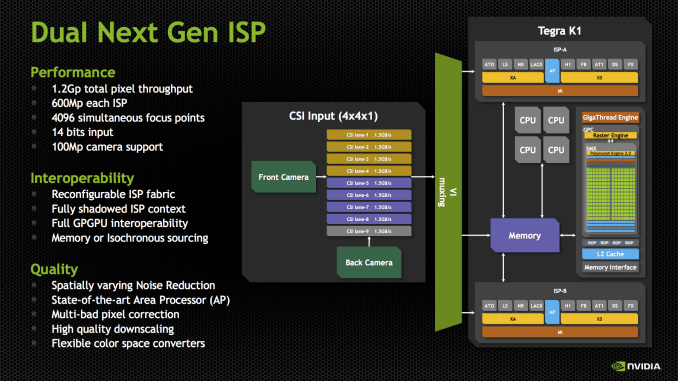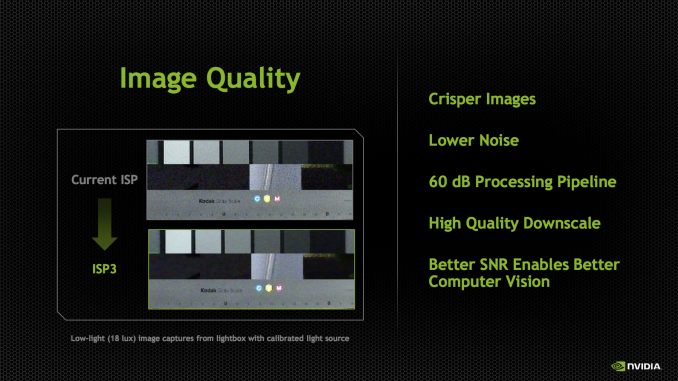NVIDIA Tegra K1 Preview & Architecture Analysis
by Brian Klug & Anand Lal Shimpi on January 6, 2014 6:31 AM ESTTegra K1 ISP & Video
NVIDIA’s Tegra K1 SoC also makes some dramatic improvements on the ISP side. We saw SoCs start arriving with two ISPs sometime in 2013, which allowed OEMs to deliver a host of new imaging experiences, like shot in shot video and simultaneous use of both front and rear cameras. With Tegra K1, NVIDIA is not only moving to two ISPs, but it’s also making ISP more of a first class citizen.
For those not familiar, ISP (Image Signal Processor) handles the imaging pipeline for still photos, video, and performs tasks like Bayer to RGB conversion (demosaicing), 3A (Autofocus, Auto Exposure, Auto white balance), noise reduction, lens correction, and so on. Although NVIDIA has always included an ISP onboard, I couldn’t shake the feeling that still imaging performance could’ve been better, especially in the few cases that allowed direct comparison (HTC One X). With Tegra K1, there’s more die area dedicated to ISP than in the past, and there are two of them to support the kind of dual camera applications that have quickly become popular.
Tegra K1 includes the third generation of NVIDIA’s ISP, capable of processing 600 MP/s on each ISP with 14 bit input, and support for up to 100 MP cameras. There are two of them, so NVIDIA quotes the total pixel throughput as up to 1.2 Gp/s. This is dramatically increased from Tegra 4, which supported up to 400 Mp/s at 10 bits per pixel. In addition the K1’s ISP now supports up to 4096 focus points, a 64x64 array, for its autofocus routine. The ISP also has better noise reduction, and local tone mapping, a feature we’ve also seen become popular for combining parts of images and recovering some of the dynamic range lost with ever shrinking pixel sizes.
Tegra K1 retains compatibility with the Chimera 1.0 features that we just saw in the Tegra Note 7, like object tracking, always-on HDR, slow motion capture, and full resolution burst, and adds more. NVIDIA has kept the Chimera brand for the K1 SoC, calling it Chimera 2.0, and envisions this architecture enabling things like better temporal pixel binning (combining 8 exposures from the CMOS to drive noise down further), faster panorama, video stabilization, and even better live preview with effects applied. The high level of Chimera seems to be the same – kernels that either run on the CPU, or on the GPU (ostensibly in CUDA this time) before or after the ISP and in a variety of image spaces (Bayer or RGB depending).
On the video side, Tegra K1 continues to support 2160p30 (4K or UHD video at 30FPS) encode and decode. Broken down another way, H.264 High Profile Level 5.1 decode and 4K H.264 High Profile 4.2 encode. The fact that there’s a Kepler next door made me suspect that NVENC was used for most of these tasks, but it turns out that NVIDIA still has discrete blocks for video encode of H.264, VP8, VC1, and others. These are the same video encode and decode blocks as what were used in Tegra 4, but with some further optimizations for power and efficiency. The Tegra K1 platform includes support for H.265 video decode as well, but this isn’t accelerated fully in hardware, rather the decode is split across NVENC and CPU.
NVIDIA showed off a K1 reference board doing 4Kp30 H.264 decode on an attached display, I didn’t notice any dropped frames. Of course that’s a given considering we saw the same thing on Tegra 4, but it’s still worth noting that the SoC is capable of driving 4K/UHD displays over eDP 1.4, LVDS and HDMI 1.4b.
The full GPIO breakdown for Tegra K1 includes essentially all the requisite connectivity you’d expect for a mobile SoC. For USB there’s 3 USB 2.0 ports, and 2 USB 3.0 ports. For storage Tegra K1 supports eMMC up to version 4.5.1, and there’s PCIe x4 which can be configured













88 Comments
View All Comments
easp - Wednesday, January 8, 2014 - link
So, it seems to me that 8 of these Denver cores would offer similar general purpose compute performance to a dual socket server from ~5-6 years ago, and yet, would make up a minuscule % of die area on a Tesla-class GPU die...Krysto - Saturday, January 11, 2014 - link
Some also say a Denver core should equal the Sandy Bridge core in performance, which would be quite impressive. That's what I have in my laptop, and it was a pretty high-end one 2 years ago.OreoCookie - Sunday, January 12, 2014 - link
Who wrote that, can you provide a link? I haven't seen any such claims. And I'm fairly sure nVidia would have mentioned that during the press event. Apple's A7 packs about the same punch as a Core 2 Duo, so it'd not be out of the question, but I'd be more cautious, especially seeing how high Intel's cpus turbo these days.PC Perv - Saturday, January 11, 2014 - link
How can you make so many definitive statements over what was essentially a PR pitch? It's too bad there is no "critics" or ombudsman to hold these bloggers accountable over time. (Granted that is also why these bloggers will never garner respects from mainstream media) These bloggers seemingly get away with anything they say as long as they keep their industry friends happy.If anyone wants to know what I am talking about, go back 2 ~ 3 years and check these clowns' articles. And check if they ever, i mean EVER, acknowledge their misjudgments or stupidity.
PC Perv - Saturday, January 11, 2014 - link
For instance, do you guys have any follow up on Tegra 4i?http://www.anandtech.com/show/6787/nvidia-tegra-4-...
Or ist it just the way it is with you guys? Just blow fanfare whenever OEM does a press conference, and completely forget about it in less than a year?
Have you no shame?
TheJian - Tuesday, January 14, 2014 - link
What fanfare? T4i is a Q1 product and the modem just got certified on ATT last month or so. The whole point of the T4i is the modem and phones so what is the problem? NV already showed it doing 150mbps (an update from 100mbps preview info) and this hasn't even been rolled out yet (anybody else running this besides Honk Kong/Singapore?). What do you want them to report? This product has been PULLED IN along with K1 at the cost of some T4 delay and sales. This is not news and everyone (even this NV hating site) has reported it :) T4i if late at all is only because of the modem awaiting which after checking happened Early Nov.Not sure this new modem speed is even interesting with caps we have today. At 50mbps on cable I can clock ~325GB or so pegged all day (that's north of 10TB/month). Even Hong Kong has a 10GB cap which is what, like 5x USA caps at 2GB usually? Even in HK that's only ONE 1080p flick and some browsing? I hope we start seeing Cell phone bill lawsuits soon that tie up these CAPPED companies so badly they are forced to stop this crap just due to litigation cost fears. But I think this is probably a pipe dream until google or someone else can offer unlimited mobile.
IE, google mentions rolling out Gbit internet in Austin, and ATT goes on immediate defense announcing huge speed upgrades (20x faster to 300mbps) and a future upgrade past that on the books not long after. So it is terribly expensive and not doable before google, but the same week google announces their roll-out, ATT can suddenly roll-out a huge upgrade and BEAT google's roll-out dates...LOL. But to match google's prices ($70) you have to OK them spying on you...ROFL. At least Google forced the updates.
http://www.theverge.com/2013/12/11/5200250/at-t-be...
Then claims they can deny google access to poles a few days later:
http://arstechnica.com/tech-policy/2013/12/why-att...
We can only hope the city votes on 23rd (next week) to allow low pole access pricing. Hard to say google would lose offering free internet to 100 libraries and public joints in the city that the CITY chooses, but they already delayed so maybe they're stupid or bribed heavily. :)
Maybe google just needs to announce everywhere and get ATT etc to announce matching $70 pricing then just say "just kidding". :) At worst they seem to easily force monopolies to respond as shown here. I hope they do the same in phones, amazon and apple too (heck MS also). We need all these big tech dogs to bark at cell providers big time and threaten their business models in any way they can. Competition from outsiders is sorely needed in cell or we'll be stuck with Verizon/ATT etc caps forever.
phoenix_rizzen - Thursday, January 16, 2014 - link
Rogers in Canada has 150 Mbps LTE using their 2600 MHz spectrum. It's been live for about a year now.They ran a speedtest competition around the time they lit up the first 2600 MHz towers in Ontario, and there were a *lot* of entries showing over 90 Mbps entries. It's listed somewhere on their Redboard blog.
My phone only does 100 Mbps LTE, and our town doesn't yet officially have LTE (there are 2 towers with it enabled out of the dozen or so towers in town), but I can get a consistent 40 Mbps on speedtests, with the occasional jump over 70.
So, if backward old Canada can get 150 Mbps LTE working, anywhere should be able to. :)
Oh, and 6 GB data plans are very common up here.
tipoo - Thursday, November 6, 2014 - link
I wonder if the code morphing has anything to do with the Nexus 9s performance inconsistency? Does amazing in most singular benchmarks, but when thrown multitasking or unpredictable code it chokes.